K Thomas Lawson is proud to be a division of Bartlett Tree Experts, and our staff now has the backing of an international tree-care company and tree research laboratory to help continue providing excellent tree service and shrub care in the Charlottesville, Virginia area. View a complete list of professional tree services offered by Bartlett.
Planting your new tree
that came balled and burlapped
|
Grab your tools:
|
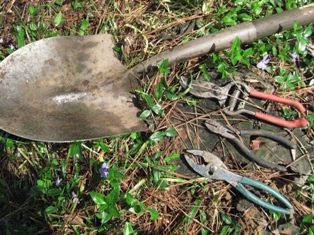 |
Digging the hole
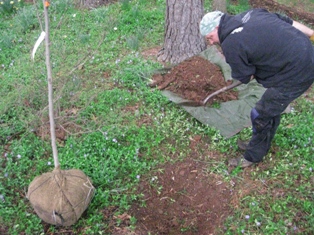
When digging your hole, make sure that it is plenty wide to accommodate future tiny feeder roots that will grow quickly and fill the planting area. I suggest a hole 2 to 3 times as wide as the ball.
The hole should not be deep. I suggest making the hole about two-thirds as deep as the ball on the tree. Store the soil nearby for later.; a bucket or tarp will make for easy clean up. I prefer a tarp, as I can sort the soil and use the most loamy parts.
Do you have clay in your planting area?
The prevalent clay in our area can be recycled to another location. When using a shovel against clay, the cutting and subsequent smearing of soil by the shovel creates glazed surface which can act as a water barrier, and an impenetrable underground wall to roots. To increase the permeability of the new hole, break up the sides of the hole with a spading fork, hand cultivator, or the tip of the shovel. This simple step will decrease the chance of the tree drowning in a stagnant pool of water, give the roots plenty of room, and prevent roots from doubling back around and girdling each other or the trunk.
Not too deep!
Planting the new tree too deep is the number one cause of future problems. The soil should never be touching the natural root flare of the tree. I commonly see trees with soil packed up around thr trunk two or three inches and have often seen trees planted ten to twelve inches too deep!!
Too much soil around the trunk will not promote stability, but instead makes the trunk bark soggy and prone to mold and fungus and hampers the flow of nutrient through the vascular system. Obviously if there is too much soil all the way up the trunk, all the feeder roots are far too deep as well. We’ll talk more about that below. The same conditions for the tree can be created by too much mulch. Go to page on proper mulching.
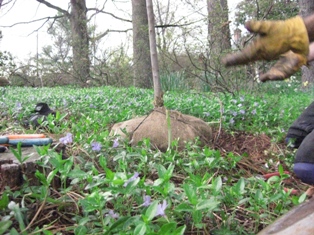
Again, not so deep. See how this tree is almost sticking out of the ground too much? When complete, the tree will settle down to a perfect level spot.
Remove ALL the wire, burlap and strings
Once you get the tree in the shallow hole, begin to remove
the cage and burlap. Remove all of the
human trappings—cage, burlap, rope, string, tag, plastic thingys, wires, and
anything else you see! If the tree was
heavy or tall, you might want some help getting the burlap our from
underneath. Take great care through all
of this; you don’t want to damage any of the roots—a B & B tree has already
lost a significant amount of roots and what remain are critical to survival for your new tree planting!
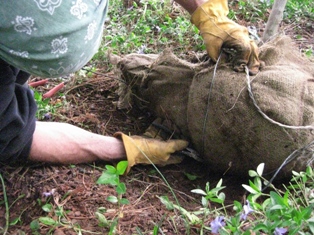 |
Tilt the tree one way and cut the wire. Then the other way and reach up under and cut all of the wire and twine. |
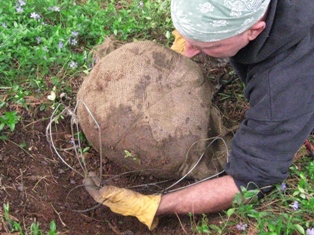
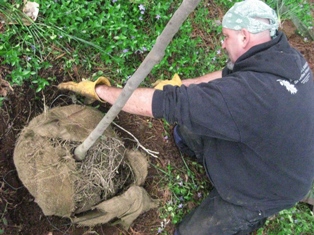 |
Cut the burlap itself to make removing it easier. |
|
Remove the entire piece of burlap and discard. |
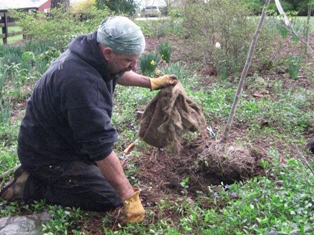 |
Now the tender loving care begins
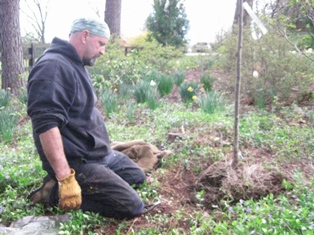 |
Time to talk to the new tree and find out if it has any specific instructions. You’ll be amazed at what you’ll understand! |
Too much soil? Tangled roots?
|
Your B&B tree may actually have too much soil around the trunk, so take time now to carefully remove some of the soil to check the condition of the roots. You may discover some major issues that you can correct now to insure the tree’s survival. |
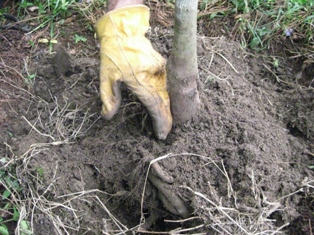 |
Roots may appear crossing or tangled from being in a ball. Separate every root that you can see and try to give it s own little space. Don’t bend or break the roots, but some may just come free when the soil has been loosened. Untangle and spread them gently so that they can be laid out across the soil and grow into stabilizing roots.
Root pruning to eliminate future problems
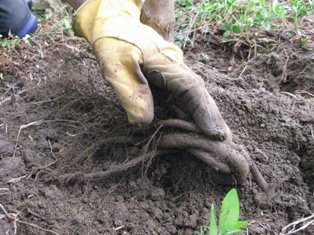 |
These roots are growing back around towards the trunk and
are potentially girdling roots. I will cut one or two away to prevent this.
Because I see this problem all the time, I know that I am taking more roots
away, but I am now doing “corrective surgery.” Keep being gentle so you don’t
loose any other roots. |
Notice all of the fine hairy roots! These are very important and will help get the tree established. Try not to damage or crush them.
Almost finished with new tree planting
|
Carefully begin to pack some soil around the roots, but
not too hard. allow the lateral roots to be spread wide. There may be few deep or tap roots. |
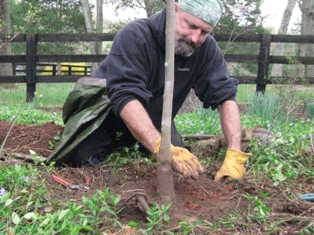 |
You can see where the soil line used to be when in the B & B. Way too high! You can also see some roots still above ground. I already pruned a few small roots that were crossing too near the trunk and this remaining cluster of roots is too involved and they are too big to cut. The tree is going to have to overcome it itself. Sorry to say, this is what you get with balled and burlapped trees, and it’s hard to know ahead of time.
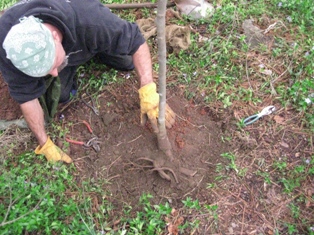
|
To accommodate the root cluster, I added just enough soil so they could be covered and help keep the tree stable. Notice the line above where the old soil line was when in the ball. |
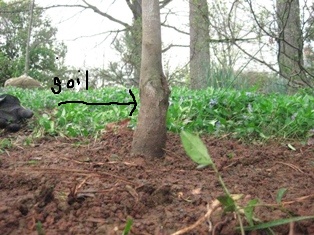 |
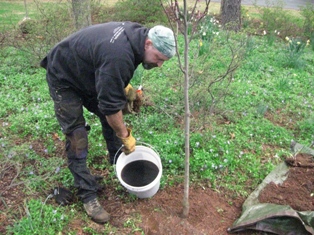 |
Talk to the tree again. Give encouragement. Tell it you will be back. Water with a root stimulant according to the manufacturer s directions. |
For the first year after planting the new tree
Keep the tree watered for the first year, when you see it has made it through to the next spring, and it is looking good, you can let the rain take over. Of course, if you have drought conditions, you must supplement the water! Those little roots have not begun to do their job efficiently yet!
Consider protection from deer, such as a small perimeter fence. This will save the tender bark from harm. Severe deer rubbing can kill a young tree.
I rarely need to stake a tree because I take care to spread the roots out as far as possible from the tree and pack gently with soil. If your tree is in a windy area, you may need to place stakes and wires, but cover them with hoses, and remove after the first full year. The roots should have taken over with all of your tender loving care.
Congratulations on your new tree planting!
Leaving Planting new tree, go to how to choose a nursery tree
Consider what is the best landscape tree for your area. Visit this outside link to a expert on what trees to choose.
